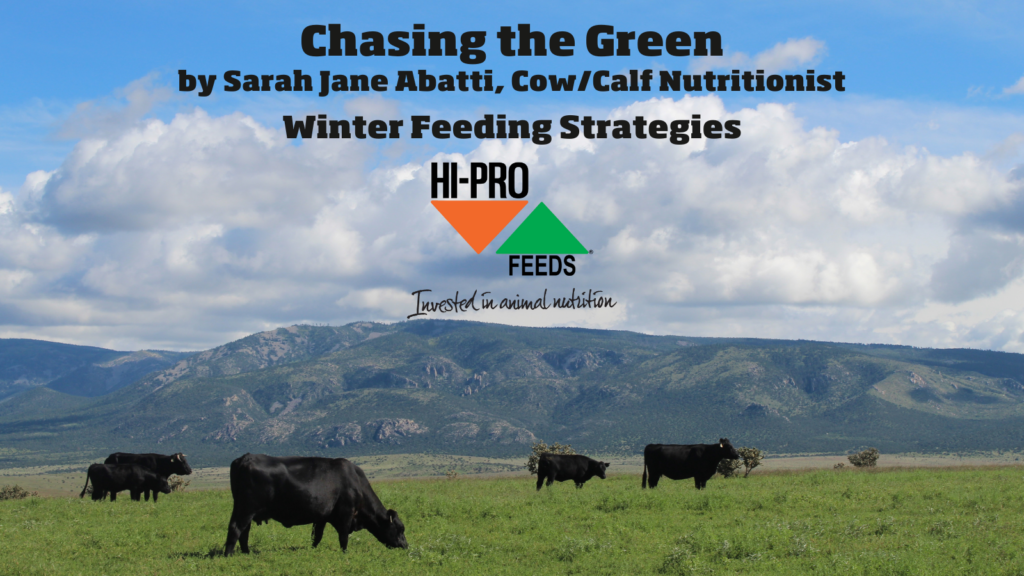Winter presents unique challenges for cattle producers as cold temperatures and reduced forage availability can impact cattle’s nutritional needs and overall health. Implementing effective winter feeding strategies is crucial to ensure that cattle maintain their weight, immunity, and reproductive performance during this demanding season. In this article, we explore key winter feeding strategies that can help cattle producers navigate the colder months while maximizing cattle productivity and well-being.
- Assessing Forage Quality and Availability:
Before the winter season begins, it is essential to assess forage quality and availability on the pasture. Determine the quantity of available forage and its nutritional content, including protein and energy levels. Understanding the available resources allows producers to plan forage supplementation accordingly and identify potential gaps in cattle nutrition.
- Fecal Scoring:
Monitoring fecal consistency provides insight to possible protein or energy deficiencies. Cow pies are scored on a scale of 1-3: Score 1 is loose feces, such as that of wheat pasture cattle and indicates a high protein/low fiber diet. A score 2 looks like a thick pancake and indicates a balanced diet of protein and fiber. Finally, a score 3 stacks like a sandcastle with multiple layers and generally indicates a low protein/high fiber diet. As a rule of thumb, when more than half of the fresh feces around a water trough are stacked (fecal score of 3), supplementation should begin or increase. It is recommended to increase supplementation by 1 lbs/hd/day until less than half of the feces are stacking and more are a score 2. Producers can also use the Cow Poop Analyzer app available from Texas A&M Agrilife.
- Adjusting Nutritional Requirements:
Forage is more likely to be energy deficient than protein deficient in the winter months. Cattle have higher energy requirements during this time to maintain body temperature and cope with colder conditions. Evaluate the nutritional needs of different cattle groups, such as lactating cows, growing calves, and mature bulls, and adjust their diets accordingly. High-quality forages, such as hay or silage, and supplemental energy feeds can bridge any nutritional gaps.
- Protein Supplementation:
Forages during winter may be deficient in protein, a crucial nutrient for cattle’s immune function and reproductive performance. Offering protein supplements, such as protein blocks, cubes, or tubs can enhance cattle nutrition and support overall health during this critical period. When choosing a protein level, it is important to remember that higher protein supplements promote forage intake. It is recommended to feed lower protein feeds (in the 20% CP range) at a slightly higher quantity than higher protein feeds if the grass is short.
- Managing Feeding Frequency:
In extreme cold, cattle may need to consume more feed to generate sufficient body heat. Increasing the frequency of feeding during the coldest hours of the day can help maintain cattle’s energy reserves and prevent excessive weight loss. Note that high fat feed supplements should not be fed in high amounts like corn gluten or sunflower meal based feeds. Feeding in excess of a high fat cube can disrupt the rumen environment and cause mild acidosis on range cattle.
- Providing Fresh Water:
Access to clean and fresh water is crucial, even during winter. In freezing conditions, ensure water sources remain ice-free using tank heaters or by breaking ice regularly. Proper hydration supports digestion and nutrient absorption, preventing dehydration and promoting cattle well-being.
- Monitoring Body Condition:
Regularly monitor cattle body condition throughout the winter season. Assessing body condition scores can help identify any nutritional deficiencies or health issues early on, allowing for timely adjustments to feeding strategies. Body Condition Scores (BCS) are evaluated on a scale of 1-9. The difference between each score is about 100 lbs. A “perfect” score is a 5, however, everyone’s definition of perfect is different. Whatever your BCS score 5 is, cattle should be slightly above a 5 going into winter as they will lose weight throughout the colder months.
- Feeding Mineral Supplements:
Offering a well-balanced mineral supplement is vital to address potential mineral deficiencies in winter forages. Minerals such as calcium, phosphorus, and trace minerals support bone health, reproduction, lactation, and immunity. A mineral supplementation program should compliment good water and offset “bad water”. For example, producers in high sulfur areas should consider mineral supplements that are low in sulfur and high in copper.
Implementing effective winter feeding strategies is essential for cattle producers to navigate the challenges of the colder months while ensuring optimal cattle nutrition and health. By assessing forage quality, fecal scoring, adjusting nutritional requirements, and offering appropriate supplements, producers can support their cattle’s productivity and well-being throughout the winter season. Careful planning and attentive management contribute to successful winter feeding, setting the stage for a thriving and profitable cattle operation in the coming year. Each of these topics will be expanded upon in future articles.

